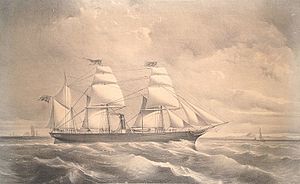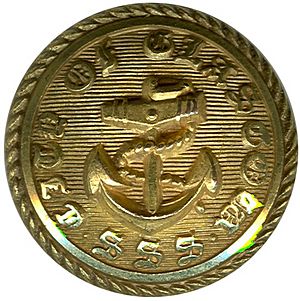SS City of Glasgow facts for kids
class="infobox " style="float: right; clear: right; width: 315px; border-spacing: 2px; text-align: left; font-size: 90%;"
| colspan="2" style="text-align: center; font-size: 90%; line-height: 1.5em;" | 
|}
Button from an officer's uniform
The SS City of Glasgow was a passenger steamship built in 1850. She was part of the Inman Line and used a single screw to move through the water. Sadly, the ship disappeared in March 1854 while sailing from Liverpool to Philadelphia. All 480 people on board, including passengers and crew, were lost.
The City of Glasgow was special because it showed that large steamships could make money on the Atlantic Ocean without needing money from the government. This idea was first explored by Isambard Kingdom Brunel's SS Great Britain in 1845. After being updated in 1852, the City of Glasgow also became the first Atlantic steamship to carry steerage passengers. This meant that immigrants had much better conditions when traveling.
Contents
- Building the City of Glasgow
- The Ship's Journeys
- The Mysterious Disappearance
- Images for kids
- More to Explore
Building the City of Glasgow
The City of Glasgow was built by a company called Tod & Macgregor in Partick, Glasgow. She was launched into the water on February 28, 1850. When she was first built, the ship could carry 44 first-class passengers and 85 second-class passengers. She also had room for 1,200 tons of cargo.
Her hull was made of iron. This was a big deal because iron hulls cost much less to fix than the wooden hulls used on most ships back then. Also, the City of Glasgow used a propeller instead of big paddle wheels. This design allowed more space inside the ship for passengers and cargo.
The City of Glasgow was not built for speed. Her fastest trip across the Atlantic took 14 days and 4 hours. This was almost four days longer than the fastest ship at the time, the Asia from the Cunard Line. Even though she was slower, the City of Glasgow was very good at saving fuel. She used only 20 tons of coal per day, while the Asia used 76 tons. This made her much cheaper to run.
The Ship's Journeys
The City of Glasgow first made five trips between Glasgow and New York City for her builders, Tod & Macgregor. Her very first journey started on April 15, 1850. She was the first steamship ever to travel from Glasgow to New York.
Later that year, on October 5, 1850, a man named William Inman convinced his business partners to buy the City of Glasgow. They formed a new company called the Liverpool and Philadelphia Steam Ship Company, also known as the Inman Line. The ship then started sailing on the Liverpool to Philadelphia route from December 17, 1850.
In 1852, the Inman Line started carrying immigrants. The City of Glasgow was changed to make room for 400 more third-class passengers in her lower decks. This was a big improvement for immigrants traveling to new countries.
Tickets for private cabins cost between fifteen and twenty-one guineas for each bed. Passengers traveling in steerage, which was a more basic and cheaper option, paid eight guineas. If you wanted to bring your dog, it cost £3!
The Mysterious Disappearance
The City of Glasgow left Liverpool on March 1, 1854. There were 480 people on board. This included 111 passengers in cabins, 293 in steerage, and a crew of 76. The ship was commanded by Captain K. Morrison. This was his first time as captain of the City of Glasgow, but he had been the ship's chief officer for many months and knew the Atlantic well. The ship was expected to return from Philadelphia on March 25, 1854.
However, no one ever heard from the ship after she left Liverpool. Another ship, the City of Manchester (which was the City of Glasgow's sister ship), reported seeing many icebergs and large areas of ice on her journey from Philadelphia on March 8. Other ships also said there was more ice than they had seen in many years. Large icebergs were right in the path that steamships usually took.
When the ship's owners heard about the delay, they thought the ship might just be stuck in the ice. They said the ship had plenty of water, coal, and food. But by the end of May 1854, it was clear that the City of Glasgow was lost. The ship and its cargo were insured for £50,000.
What happened to the City of Glasgow is still a mystery. Newspapers at the time reported different sightings of the ship, but these stories often did not match up. For example, one captain saw a large steamer that was leaning to one side, but he said it didn't look like the City of Glasgow. Another ship found the hull of a large iron vessel that seemed to be built in Glasgow, and people thought it might be the City of Glasgow. However, the ship's owners found out it was actually another ship called the Shannon.
Later, on October 25, 1854, a piece of the front of a ship, with the name City of Glasgow written in gold letters, washed ashore near Campbeltown. But there was another ship named City of Glasgow that sailed from Glasgow around the same time. It's possible that this piece of wreckage came from that other ship.
Images for kids
SS City of Glasgow
| History | |
|---|---|
| Name | City of Glasgow |
| Namesake | Glasgow |
| Owner | |
| Port of registry | Glasgow |
| Route |
|
| Ordered | 1849 |
| Builder | Tod & Macgregor, Partick, Glasgow |
| Yard number | 57 |
| Launched | 28 February 1850 |
| Christened | 28 February 1850 by Miss M. Galbraith |
| Completed | April 1850 |
| Maiden voyage | 16 April 1850 |
| Fate | Lost at sea, March 1854 |
| General characteristics | |
| Type | Ocean liner |
| Tons burthen | 1,610 bom |
| Length | 227.5 ft (69.3 m) |
| Beam | 32.7 ft (10.0 m) |
| Depth | 24.7 ft (7.5 m) |
| Propulsion |
|
| Sail plan | 3-masted barque |
| Capacity | 137 cabin passengers as built. 400 steerage added later. |
| Crew | 70 |
More to Explore
- List of ocean liners
- List of shipwrecks
- List of United Kingdom disasters by death toll



